PONTIAC GRAND-PRIX 1993 Owner's Manual
Manufacturer: PONTIAC, Model Year: 1993, Model line: GRAND-PRIX, Model: PONTIAC GRAND-PRIX 1993Pages: 338, PDF Size: 17.3 MB
Page 21 of 338
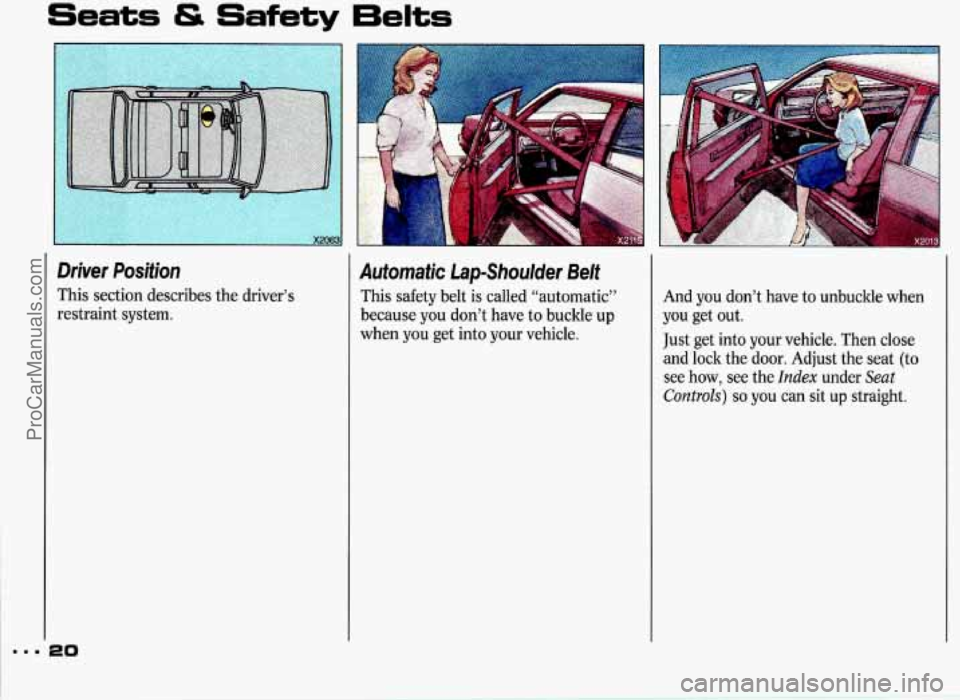
...
Seats & Safety 6elts
Driver Position
This section describes the driver’s
restraint system.
20
Automatic Lap-Shoulder Belt
This safety belt is called “automatic”
because you don’t have to buckle up
when you get into your vehicle. And you don’t have to unbuckle when
you get out.
Just get into your vehicle. Then close
and lock the
door. Adjust the seat (to
see
how, see the Index under Seat
Controls) so you can sit up straight.
ProCarManuals.com
Page 22 of 338
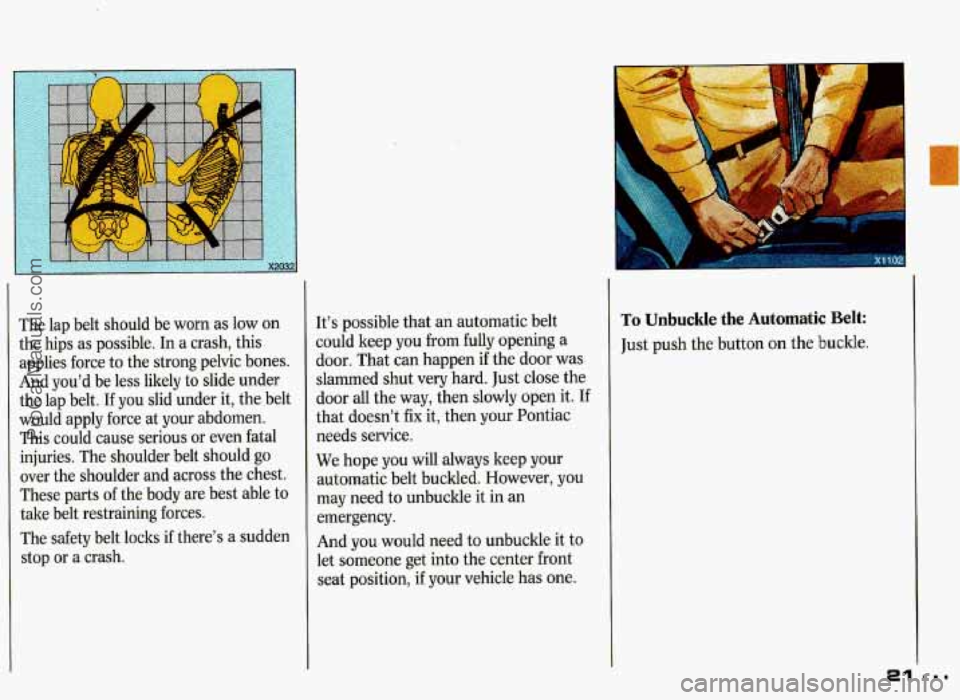
I
The lap belt should be worn as low on
the hips as possible.
In a crash, this
applies force to the strong pelvic bones.
And
you’d be less likely to slide under
the
lap belt. If yau slid under it, the belt
would apply
force at your abdomen.
This could cause serious or even fatal
injuries. The shaulder belt should
go
over the shoulder and across the chest.
These
parts of the body are best able to
take belt restraining forces.
The safety belt loclcs if there’s a sudden
stop
or a crash.
It’s possible that an automatic belt
could keep
you from €idly opening a
door. That can happen if the door was
slammed shut
very hard. Just close the
door all the
way, then slowly open it. I€
that doesn’t fix it, then your Pontiac
needs service.
We hope
you will always keep your
automatic belt buckled. However, you
may need to unbuckle it in an
emergency.
And
yau would need to unbuckle it to
let someone get into the center front
seat position, if your vehicle has one.
To Unbuckle the Automatic Belt:
Just push the button on the buclde.
ProCarManuals.com
Page 23 of 338
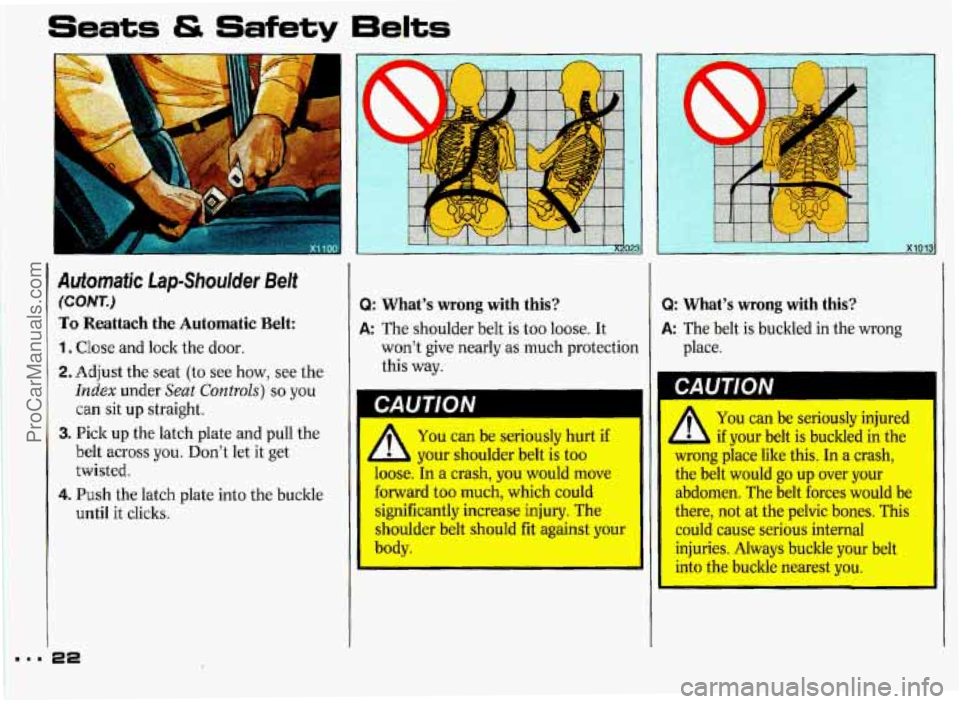
Seats & Safety
-1
1
I
Automatic Lap-Shoulder Belt
(CONr.)
TQ Reattach the Automatic Belt:
1. Close and lock the door.
2.Adjust the seat (to see how, see the
Index under Seat Controls) so you
can sit up straight.
3. Pick up the latch plate and pull the
belt across you. Don’t let it get
twisted.
until it cliclts.
4. Push the latch plate into the buckle
Belts
22
Q: What’s wrong with this?
A: The shoulder belt is too loose. It
won’t give nearly as much protectior
this way.
You can be seriously hurt if
L your shoulder belt is too
loose. In a crash, you would move
forward too much, which could
signiticantly increase injury. The
shoulder
belt should fit against your
bodv.
I
Q: What’s wrong with this?
A: The belt is buckled in the wrong
place.
You can be seriously injured
b if your belt is buckled in the I
the belt would go up over your
there, not at the pelvic bones. This
could cause serious internal
injuries. Always buckle your belt
into the buckle nearest you.
abdomen. The belt forces would be I
ProCarManuals.com
Page 24 of 338
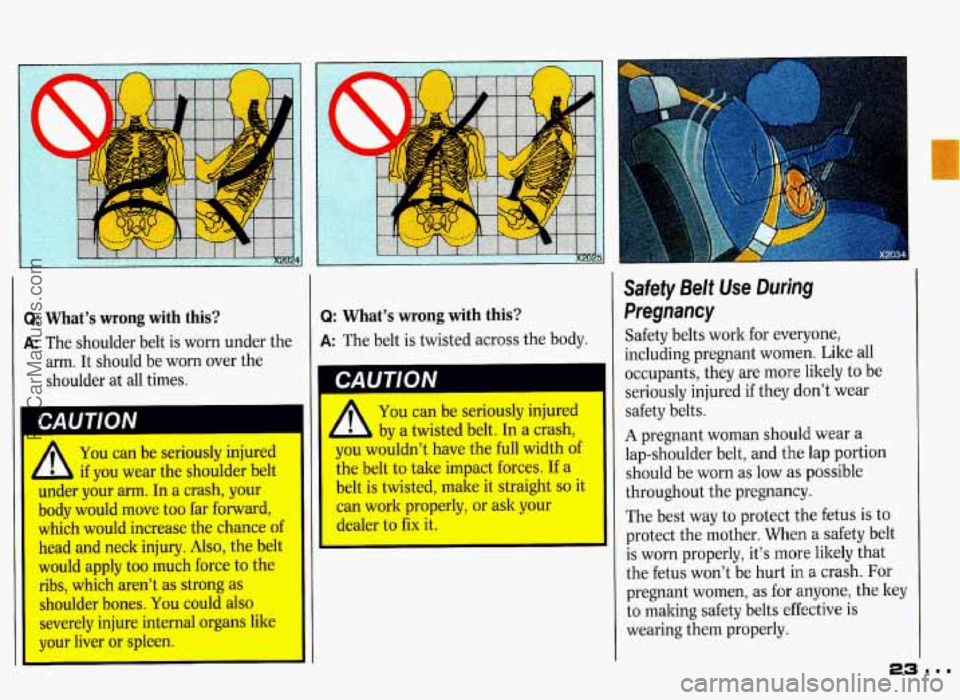
2: What’s wrong with this?
k The shoulder belt is worn under the
arm. It should be worn over the
shoulder at ail times.
1 CAUTlON I
You can be seriously injured
if you wear the shoulder belt
under your arm. In a crash, your
body would move too far forward,
which would increase the chance of
head and neck injury.
Also, the belt
would apply too much force to the
ribs, which aren’t as strong as
shoulder bones. You could also
severely injure internal organs like
your liver or spleen.
I
Q: What’s wrong with this?
A: The belt is twisted across the body.
11 CAUTION
You can be seriously injured
by a twisted belt. In a crash,
you wouldn’t have the full width of
the belt to take impact forces.
If a
belt is twisted, make it straight
so it
can work properly, or ask your
dealer to fix it.
Safety Belt Use During
Pregnancy
Safety belts work for everyone,
including pregnant women. Like all
occupants, they are more likely to be
seriously injured
if they don’t wear
safety belts.
A pregnant woman should wear a
lap-shoulder belt, and the lap portion
should be worn as low
as possible
throughout the pregnancy.
The best way to protect the fetus
is to
protect the mother. When a safety belt
is worn properly, it’s more likely that
the fetus won’t be hurt in a crash. For
pregnant women, as for anyone, the key
to making safety belts effective is
wearing them properly.
L
23.m.
ProCarManuals.com
Page 25 of 338
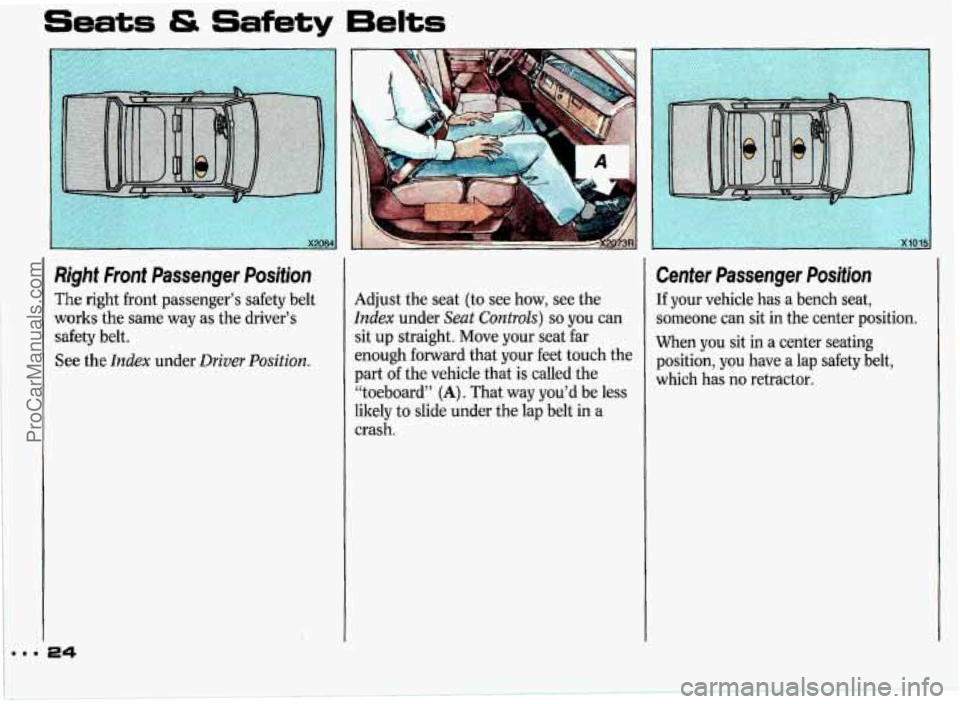
Seats & Safety 6elts
Right Front Passenger Position
The right front passenger’s safety belt
works the same way as the driver’s
safety belt.
See the
Index under Driver Position.
... 24
k
Adjust the seat (to see how, see the
Index under Seat Controls) so you can
sit up straight. Move your seat far
enough forward that your feet touch the
part
of the vehicle that is called the
“toeboard”
(A). That way you’d be less
likely to slide under the lap belt in a
crash.
Center Passenger Position
If your vehicle has a bench seat,
someone can sit in the center position.
When you sit in
a center seating
position, you have
a lap safety belt,
which has no retractor.
ProCarManuals.com
Page 26 of 338
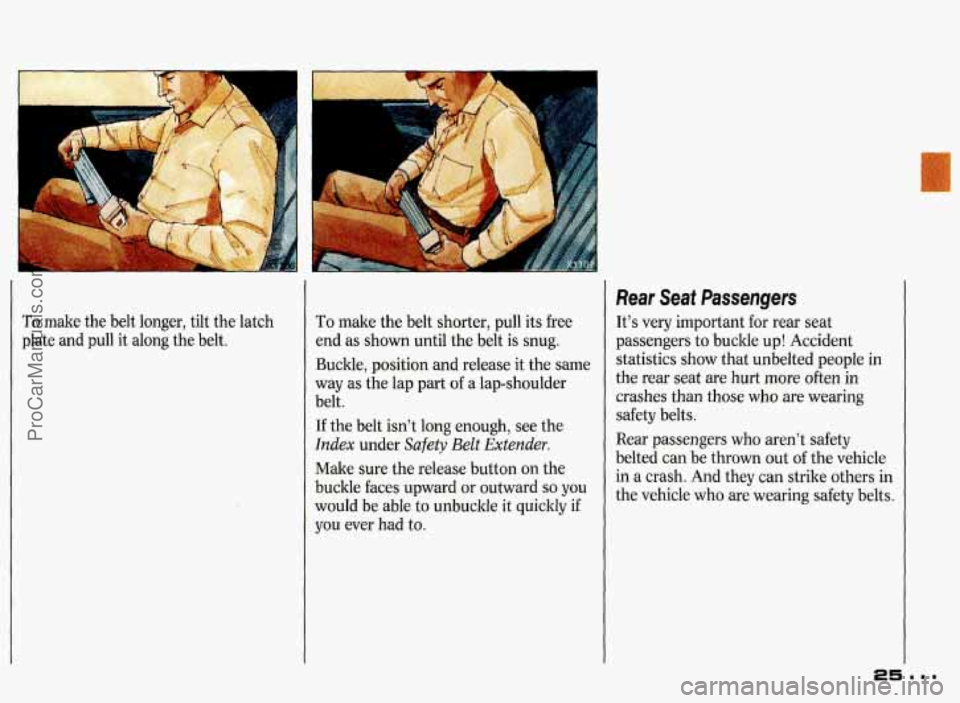
To make the belt longer, tilt the latch
plate and pull it along the belt. To make the belt shorter, pull its free
end
as shown until the belt is snug.
Buckle, position and release it the same
way as the lap part of a lap-shoulder
belt.
If the belt isn’t long enough, see the
Index under Safety Belt Extender.
Make sure the release button on the
buckle faces upward or outward
so you
would be able to unbuckle it quicltly if
you ever had to.
Rear Seat Passengers
It’s very important for rear seat
passengers to buckle up! Accident
statistics show that unbelted people in
the rear seat are hurt more often in
crashes than those
who are wearing
safety belts.
Rear passengers
who aren’t safety
belted can be thrown out of the vehicle
in a crash. And they can strike others
in
the vehicle who are wearing safety belts.
ProCarManuals.com
Page 27 of 338
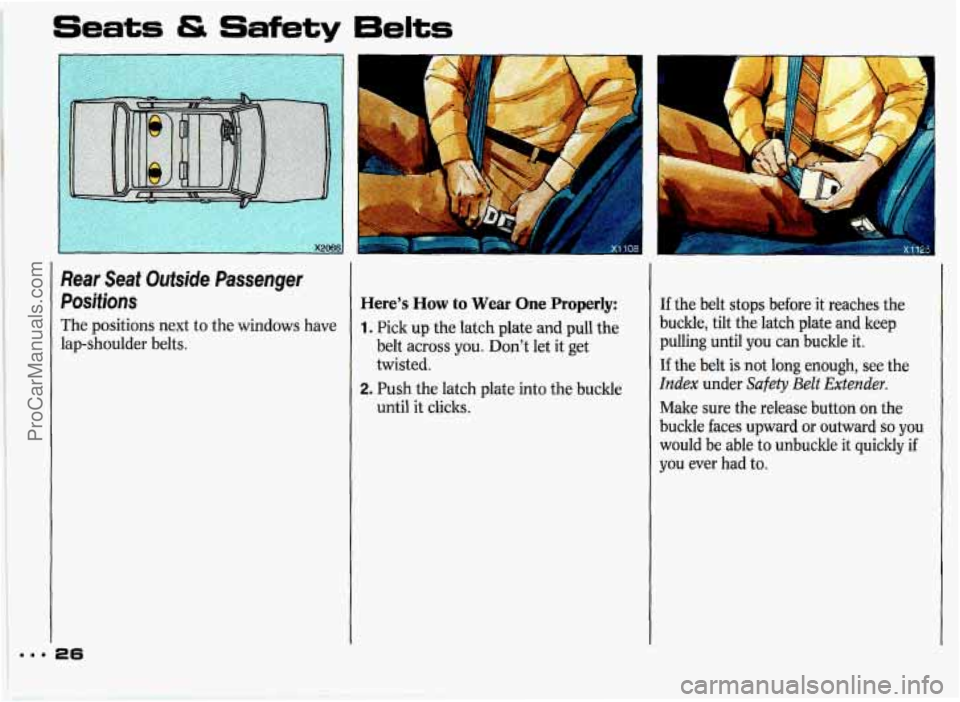
Seats & Safety 6elts
Rear Seat Outside Passenger
Positions
The positions next to the windows have
lap-shoulder belts.
Here's How to Wear One Properly:
1. Pick up the latch plate and pull the
belt across
you. Don't let it get
twisted.
until it clicks.
2. Push the latch plate into the buckle If
the belt stops before it reaches the
buckle, tilt the latch plate and keep
pulling until
you can buckle it.
If the belt is not long enough, see the
Index under Safety Belt Extender.
Make sure the release button on the
buckle faces upward or outward
so you
would be able to unbuckle it quickly if
you ever had to.
ProCarManuals.com
Page 28 of 338
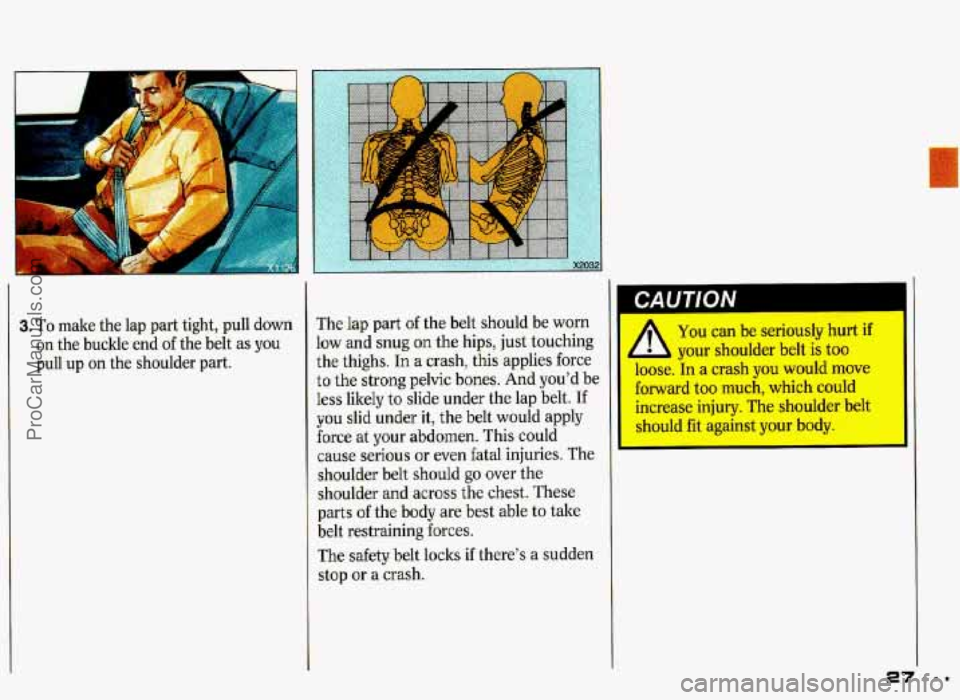
3. To make the lap part tight, pull down
on the buckle end of the belt as you
pull up on the shoulder part. The
lap part
of the belt should be worn
low
and snug on the hips, just touching
the thighs.
In a crash, this applies force
to the strong pelvic bones. And you’d be
less likely to slide under the lap belt.
If
you slid under it, the belt would apply
force at
your abdomen. This could
cause serious
or even fatal injuries. The
shoulder belt should
go over the
shoulder
and across the chest. These
parts
of the body are best able to take
belt restraining forces.
The safety belt locks if there’s a sudden
stop or
a crash.
CAUTION
A You can be seriously hurt if
A your shoulder belt is too
Lse. In a crash you would move
forward too much, which could
increase
injury. The shoulder belt
should fit against vour body. I
ProCarManuals.com
Page 29 of 338
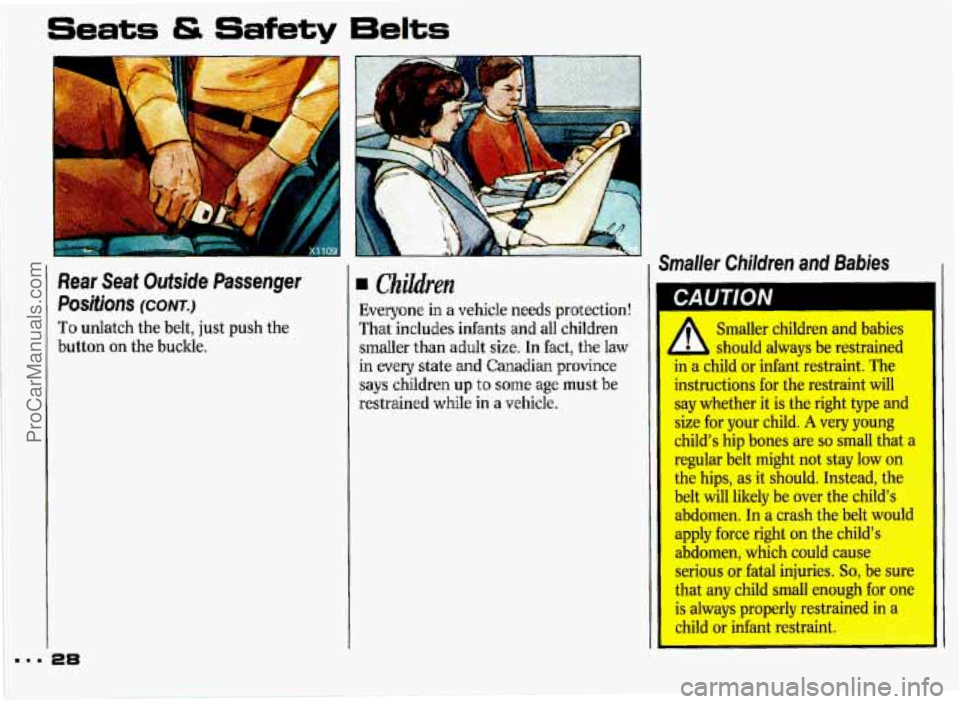
Seats & Safety 6elts
Rear Seat Outside Passenger
Positions
(CONT.)
To unlatch the belt, just push the
button on the buckle.
28
Children
Everyone in a vehicle needs protection!
That includes infants and all children
smaller than adult size. In fact, the law
in every state and Canadian province
says children
up to some age must be
restrained while in a vehicle.
Smaller Children and Babies
I CAUTION
I A Smaller children and babies
4 A should always be restrained
111 d child or infant restraint. The
instructions for the restraint will
say whether it is the right type and
size for your child.
A very young
child's hip bones are
so small that a
regular belt might not stay low on
the hips, as it should. Instead, the
belt will likely be over the child's
abdomen. In a crash the belt would
apply force right on the child's
abdomen, which could cause
serious or fatal injuries.
So, be sure
that any child small enough for one
is always properly restrained in a
child nr infmt rpstrsint.
--
ProCarManuals.com
Page 30 of 338
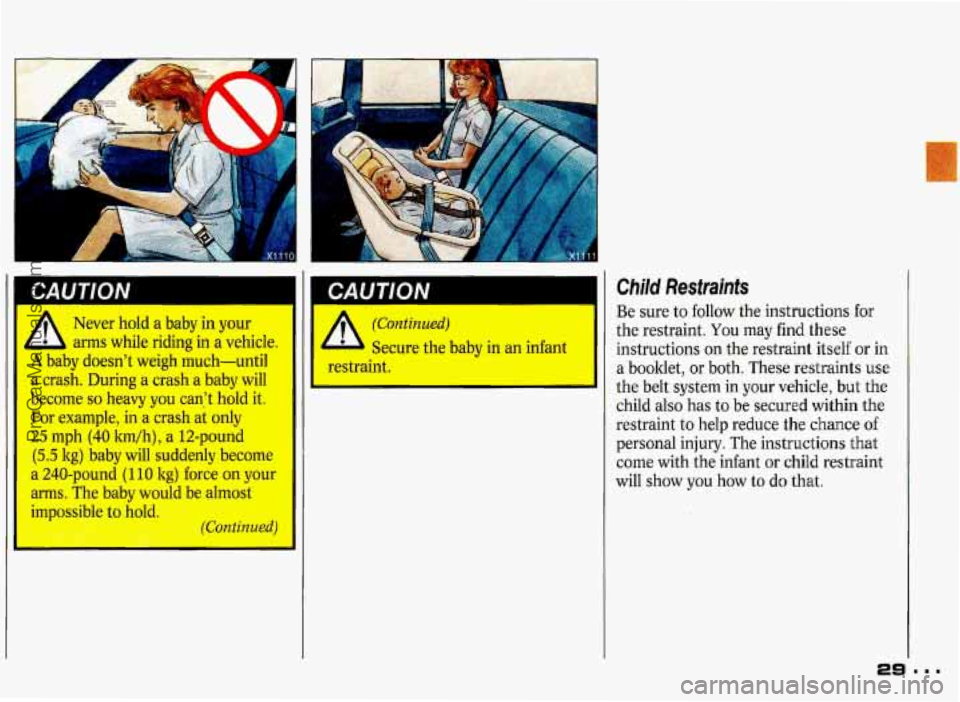
Never hold a baby in your
arms while riding in a vehicle.
I
A baby doesn't weigh much-until
a crash. During a crash a baby will
become
so heavy you can,'t hold it.
For example, in a crash at only
25 mph (40 ltm/h), a 12-pound
(5.5 kg) baby will suddenly become
a 240-pound
(1 10 kg) force on your
arms. The baby would be almost
ir---o-;ble to hold.
(Continued)
I
(Continued)
Secure the baby in an infant
restraint.
will show you how to do that.
Child Restraints
Be sure to follow the instructions for
the restraint.
You may find these
instructions
on the restraint itself or in
a booklet, or both. These restraints use
the belt system in
your vehicle, but the
child also has to be secured within the
restraint to help reduce the
chance of
personal injury. The instructions that
come with the infant or child restraint
ProCarManuals.com